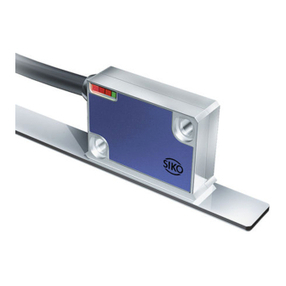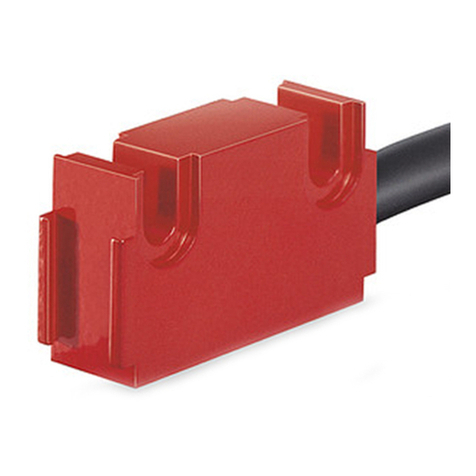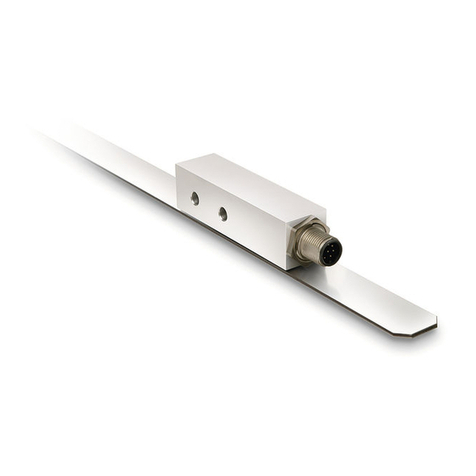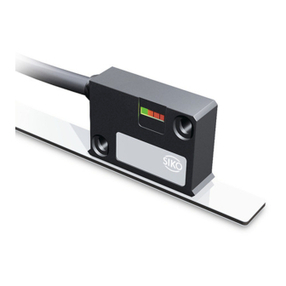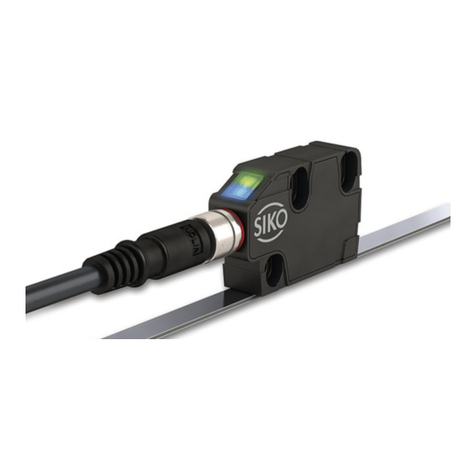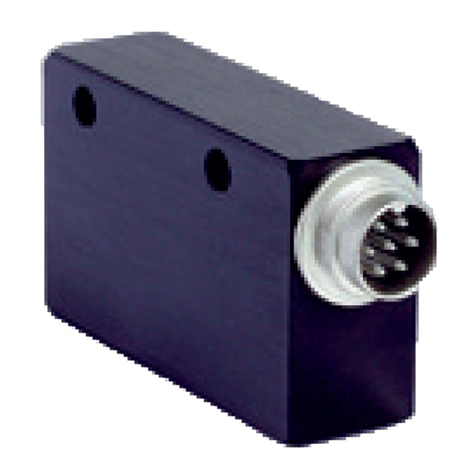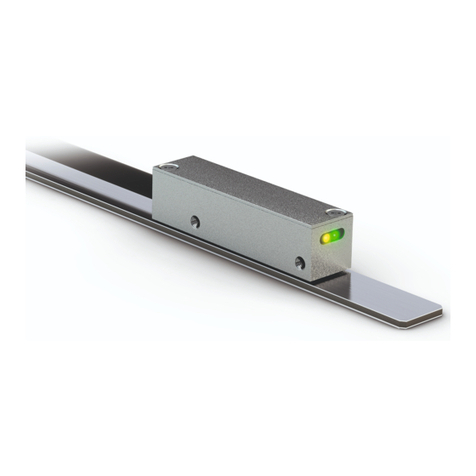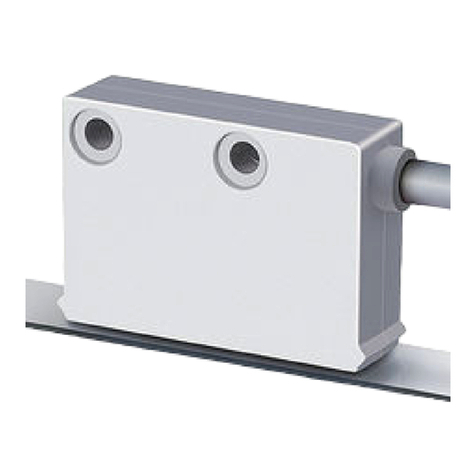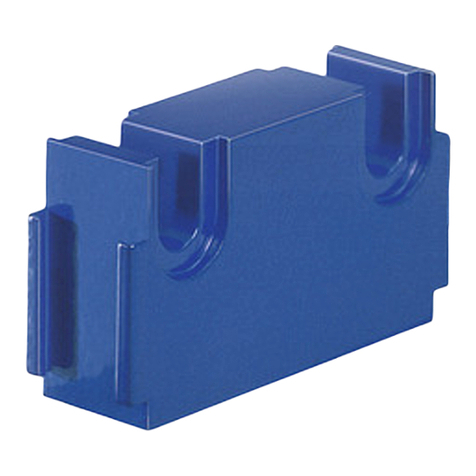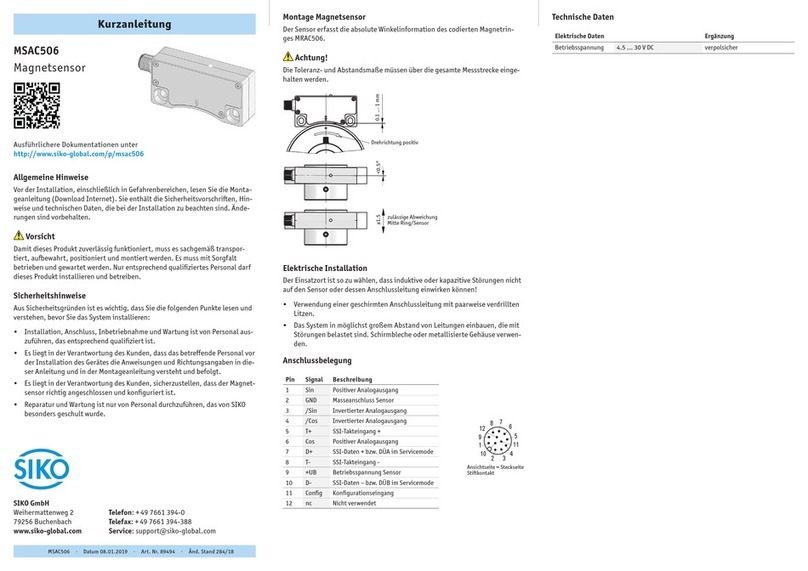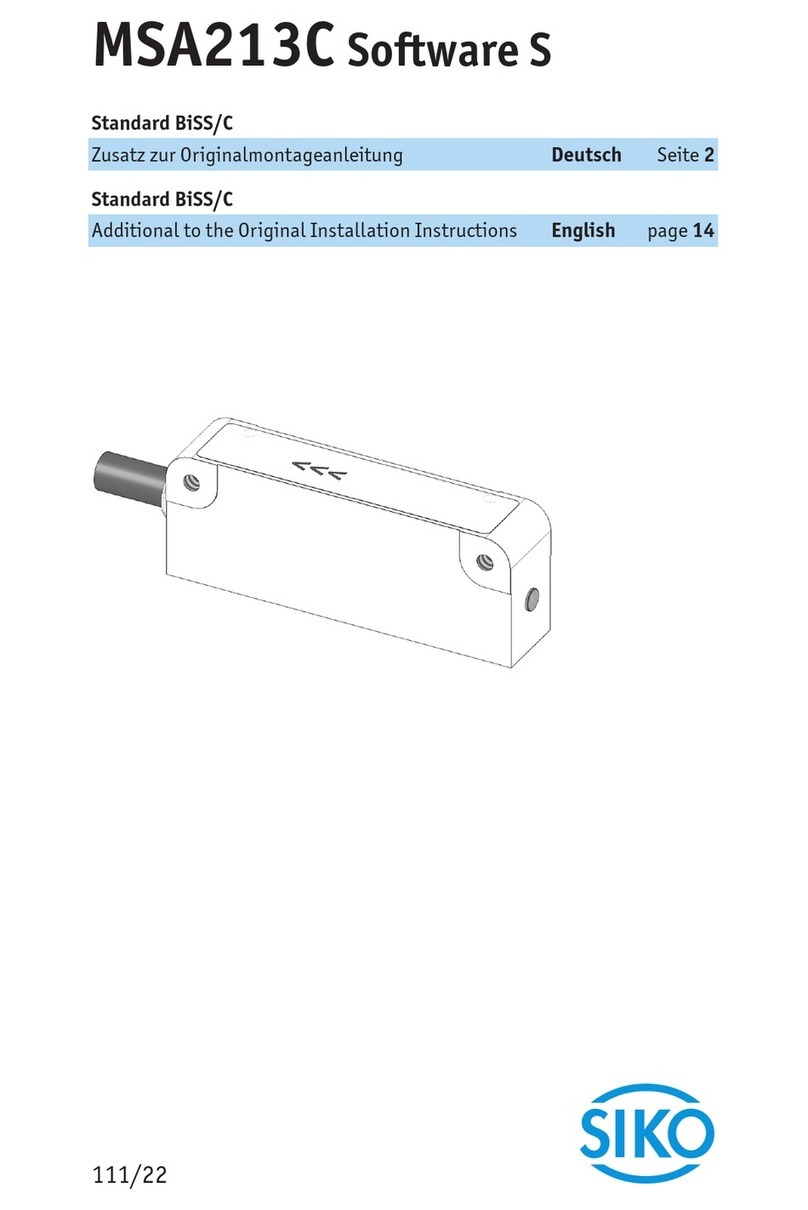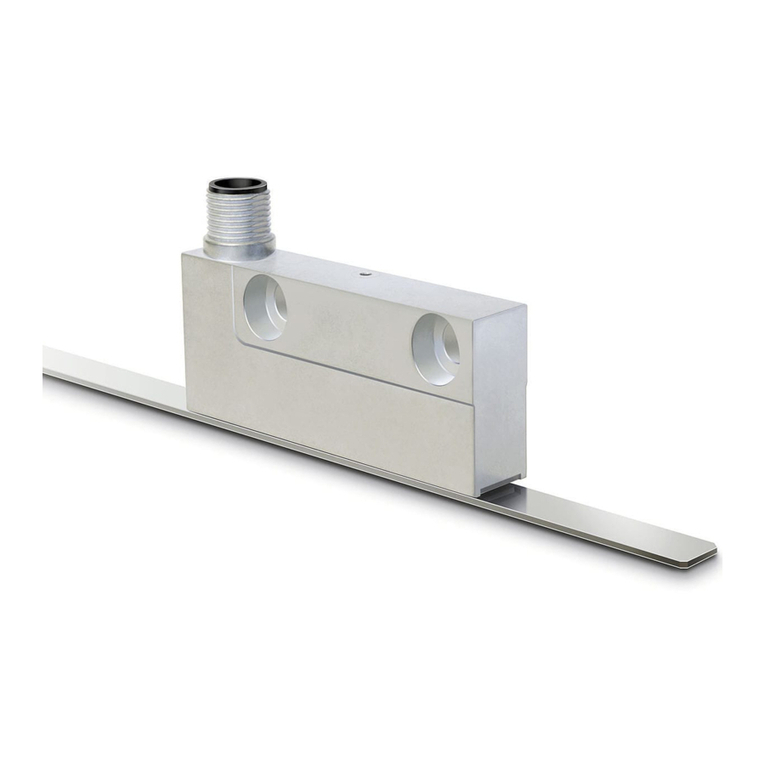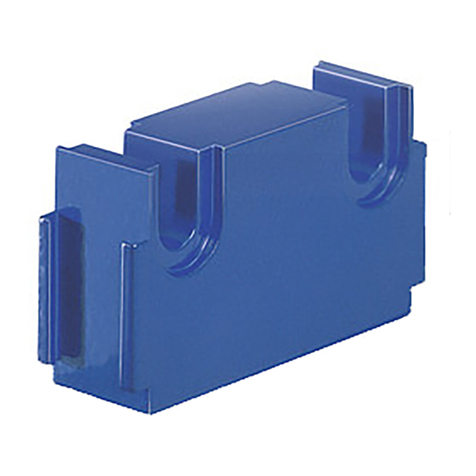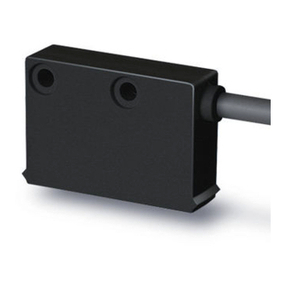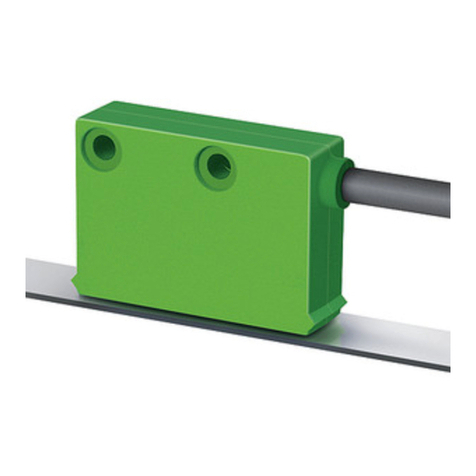Siko MSA511 Operation manual

MSA511+MBA511 Datum 15.02.2010 Art.Nr. 81105 Änd. Stand 48/10 1
Abb. 1: Ausrichtung
Bedruckung auf Band
Bedruckung auf Sensor
Verfahrrichtung
DEUTSCH
1. Gewährleistungshinweise
Lesen Sie vor der Montage und der Inbetriebnahme
dieses Dokument sorgfältig durch. Beachten Sie zu
Ihrer eigenen Sicherheit und der Betriebssicherheit
alle Warnungen und Hinweise.
Ihr Produkt hat unser Werk in geprüftem und be-
triebsbereitem Zustand verlassen. Für den Betrieb
gelten die angegeben Spezifikationen und die
Angaben auf dem Typenschild als Bedingung.
Garantieansprüche gelten nur für Produkte der
Firma SIKO GmbH. Bei dem Einsatz in Verbindung
mit Fremdprodukten besteht für das Gesamtsystem
kein Garantieanspruch.
Reparaturen dürfen nur im Werk vorgenommen
werden. Für weitere Fragen steht Ihnen die Firma
SIKO GmbH gerne zur Verfügung.
2. Identifikation
Das Typenschild zeigt den Gerätetyp mit Varianten-
nummer. Die Lieferpapiere ordnen jeder Varianten-
nummer eine detaillierte Bestellbezeichnung zu.
z.B. MSA511-0023
Varianten-Nr.
Geräte-Typ
3. Mechanische Montage
Die Montage darf nur gemäß der angegebenen IP-
Schutzart vorgenommen werden. Das System muss
ggfs. zusätzlich gegen schädliche Umwelteinflüs-
se, wie z.B. Spritzwasser, Staub, Schläge, Tempe-
•
•
•
•
ratur geschützt werden.
Achtung! Beachten Sie bei der Montage des Sen-
sors oder des Magnetbandes die richtige Ausrich-
tung beider Systemkomponenten zueinander und
Einhaltung der Montagetoleranzen (siehe auch
Abb. 7).
Benutzerinformation
MSA511 + MBA511
Magnetsensor, Magnetband
3.1 Montage Magnetband
Die Montage muss plan zur Montagefläche bzw.
der zu messenden Strecke erfolgen. Welligkeiten
verschlechtern immer die Messgenauigkeit. Es ist
für ausreichenden mechanischen Schutz zu sorgen
(z.B. gegen Schläge und Vibration).
Aus technischen Gründen muss bei der Länge,
gegenüber der Messstrecke, ein Zumaß von min.
178mm berücksichtigt werden.
Achtung! Um optimale Verklebungen zu errei-
chen müssen alle antiadhäsiven Fremdsubstanzen
(Öl, Fett, Staub usw.) durch möglichst rückstands-
los verdunstende Reinigungsmittel entfernt wer-
den. Als Reinigungsmittel eignen sich u.a. Ketone
(Aceton) oder Alkohole, die u.a. von den Firmen
Loctite und 3M als Schnellreiniger angeboten wer-
den. Die Klebeflächen müssen trocken sein und es
ist mit höchstmöglichem Anpressdruck zu verkle-
ben. Die Verklebungstemperatur ist optimal zwi-
schen 20°C und 30°C in trockenen Räumen.
Tip! Bei Verklebung langer Bänder sollte die
Schutzfolie des Klebebandes über eine kurze Teil-
strecke abgezogen werden, um das Band zu fixie-
ren. Daraufhin erfolgt das Ausrichten des Bandes.
Nun kann über die restliche Länge die Schutzfolie,
unter gleichzeitigem Andruck des Bandes seitlich
herausgezogen werden (als Andruckhilfe kann z.B.
eine Tapetenandrückwalze verwendet werden).
Montageschritte (Abb. 2)
Befestigungsfläche (1) sorgfältig reinigen.
Am Magnetband die Schutzfolie (2) des Klebe-
bandes (3) entfernen.
Magnetband (4) unter Berücksichtigung der
Pfeilrichtung aufkleben.
Magnetbandoberfläche sorgfältig reinigen.
•
•
•
•

2 MSA511+MBA511 Datum 15.02.2010 Art.Nr. 81105 Änd. Stand 48/10
Abb. 2: Montage Magnetband
Abb. 7: Montagetoleranzen
0.1 ... 2
<0.5° <3°
<1°±1.0
Abb. 3 Abb. 4
Abb. 5 Abb. 6
Am Abdeckband (5) die Schutzfolie (6) des Kle-
bebandes entfernen.
Abdeckband aufkleben (an beiden Enden leicht
überlappen lassen).
Die überlappenden Enden des Abdeckbandes gegen
Ablösen sichern.
•
•
•
Innerhalb der angegebenen Lageabweichung Abb.
7 ist der Messfehler vernachlässigbar.
Der maximale Abstand zwischen Sensor und
Band (ohne Abdeckband) beträgt 2mm. Bei
Verwendung eines Abdeckbandes reduziert sich
der eff. Abstand um die Dicke des Abdeckban-
des inkl. Klebefolie. Der Sensor sollte das Mag-
netband nicht berühren.
Die Addition der Montagetolerenzen in allen Ebe-
nen muss vermieden werden.
Achtung! Die Beeinflussung durch magnetische
Felder ist zu vermeiden. Insbesondere dürfen kei-
ne Magnetfelder (z.B. Haftmagnete oder andere
Dauermagnete) in direkten Kontakt mit dem Ma-
gnetband geraten. Gleiches gilt für den Sensor im
Betrieb.
Montagebeispiele
Die einfache Montageart, durch angeschrägtes
Schutzband (Abb. 3), ist nur in sehr geschützter Um-
gebung zu empfehlen. Bei ungeschützer Umgebung
besteht Abschälgefahr. In solchen Fällen sind Monta-
gearten, wie in Abb. 4 und 5 gezeigt, geeigneter.
Den optimalen Schutz bietet die Montage in ei-
ner Nut (Abb. 6), die so tief sein sollte, dass das
Magnetband vollständig darin eingebettet werden
kann (z.B. SIKO-PSA-Schiene).
3.2 Montage Sensor
Bei der Montage des Sensors ist unbedingt darauf
zu achten, dass die Pfeilrichtung des Sensorauf-
druckes mit der Pfeilrichtung des Bandaufdruckes
übereinstimmt (Abb. 1).
Die Lage des Sensors zum Magnetband ist genau
definiert. Bei der Montage ist insbesondere zu be-
achten, dass über die gesamte Messstrecke zwi-
schen Band und Sensor ein Luftspalt eingehalten
wird, unabhängig ob das Band oder der Sensor
bewegt werden (Abb. 7).
4. Elektrischer Anschluss
Anschlussverbindungen dürfen nicht unter
Spannung geschlossen oder gelöst werden!!
Verdrahtungsarbeiten dürfen nur spannungslos
erfolgen.
Litzen sind mit Aderendhülsen zu versehen.
Vor dem Einschalten sind alle Leitungsanschlüsse
und Steckverbindungen zu überprüfen.
Hinweise zur Störsicherheit
Alle Anschlüsse sind gegen äußere Störeinflüsse
geschützt. Der Einsatzort ist aber so zu wählen,
dass induktive oder kapazitive Störungen nicht
auf den Geber oder deren Anschlussleitungen
einwirken können! Durch geeignete Kabelfüh-
rung und Verdrahtung können Störeinflüsse (z.B.
von Schaltnetzteilen, Motoren, getakteten Reg-
lern oder Schützen) vermindert werden.
Erforderliche Maßnahmen:
Nur geschirmtes Kabel verwenden. Den Kabel-
schirm beidseitig auflegen. Litzenquerschnitt der
Leitungen 0,25mm2.
Die Verdrahtung von Abschirmung und Masse
•
•
•
•
•
•

MSA511+MBA511 Datum 15.02.2010 Art.Nr. 81105 Änd. Stand 48/10 3
Schirm
Schirm
Buchsenteil
Stiftteil
Ansichtseite =
Steckseite
(GND) muss sternförmig und großflächig erfolgen.
Der Anschluss der Abschirmung an den Potenti-
alausgleich muss großflächig (niederimpedant)
erfolgen.
Das System muss in möglichst großem Abstand von
Leitungen eingebaut werden, die mit Störungen
belastet sind; ggfs. sind zusätzliche Maßnahmen
wie Schirmbleche oder metallisierte Gehäuse
vorzusehen. Leitungsführungen parallel zu Ener-
gieleitungen sind zu vermeiden.
Schützspulen müssen mit Funkenlöschgliedern
beschaltet sein.
Spannungsversorgung: 24 VDC -20% ... +20%
Leistungsaufnahme: < 3 Watt
4.1 Anschlussbelegung (Kabellänge max. 100m)
12-pol. Stiftkontakt:
Pin Belegung
A SSI Daten-
B SSI Daten+
C SSI Takt-
D SSI Takt+
E +24VDC
F Sinus
G RS485 DÜA
H RS485 DÜB
J GND
K N.C.
L Nullungseingang
M Cosinus
4.2 Anschlussstecker
12-pol. Gegenstecker gerade
Bei SIKO als Zubehör unter Art.Nr. 76572 erhält-
lich.
•
•
Pos. 6 ... 10 über Kabelmantel schieben.
Kabel abisolieren.
Schirm umlegen.
Pos. 5 auf Litzen schieben.
Litzen an Pos. 3 löten (entspr. Anschluss-
plan).
Abstandhülse Pos. 4 aufweiten und über Litzen
stülpen, zusammendrücken und auf Pos. 3 ste-
cken. Schlitz und Nut (Pos. 3 und 4) müssen
deckungsgleich sein.
Pos. 6 an Pos. 5 drücken, überstehenden Schirm
abschneiden.
Pos. 2 und 7 aufschieben und mittels Montage-
werkzeug Pos. 11 verschrauben.
Pos. 8 in Pos. 9 stecken, beides in Pos. 7
schieben.
Pos. 10 mit Pos. 7 verschrauben.
Pos. 1 in Pos 2. schieben.
12-pol. Gegenstecker winkel
Bei SIKO als Zubehör unter Art.Nr. 79666 erhält-
lich.
1.
2.
3.
4.
5.
6.
7.
8.
9.
10.
11.
Gehen Sie schrittweise vor:
Dichtungen montieren (3x).
Kabelteile auffädeln.
Kabel und Schirm abmanteln.
Litzen durch das Gehäuse fädeln.
Schirmring, Klemmkorb montieren.
Druckschraube leicht andrehen.
1.
2.
3.
4.
5.
6.

4 MSA511+MBA511 Datum 15.02.2010 Art.Nr. 81105 Änd. Stand 48/10
+24V/GND
MSA511
Takt+/Takt-/
Daten+/Daten- z.B. MA10/3
SSI
RS232
RXD/TXD/GND
Pegelwandler
RS232 <-> RS485
RS485
DÜA/DÜB/GND
Netzteil:
24VDC/
500mA
PC
Abb. 9: Konfiguration der SIKO Messanzeige MA10/3
SSI: Datenformat: no, Geberbits: 24, Singleturnbits:
unrelevant, Ausgabecode: Gray
Konfiguration der SIKO-Messanzeige MA10/4 SSI:
Gebertyp: linear; Geberbits: 24; Faktor: 1.0 (1/100mm
Anzeige); Ausgabecode: Gray
Litzen an Kontakteinsatz löten.
Verdrehhülse in gewünschte Winkelstellung (Lage
der Nase beachten) montieren (90°-Schritte,
siehe auch Kap. "Ändern der Winkelstellung").
Kontakteinsatz, Distanzhülse einsetzen.
Deckel einhaken.
Druckschraube festziehen (ca. 10-20 Nm).
Ändern der Winkelstellung:
Druckschraube (6) leicht aufdrehen.
Deckel (10) und Distanzhülse (9) entfernen.
Kontakteinsatz (7) und Verdrehhülse (8) in
gewünschte Winkelstellung (90° Schritte)
verdrehen.
Distanzhülse, Deckel und Druckschraube mon-
tieren.
7.
8.
9.
10.
11.
1.
2.
3.
4.
grammierung beginnen, indem Sie:
ein geeignetes Terminalprogramm (z.B. sikoterm.
exe) starten und Ihre Befehle gemäß der Tabelle
"Befehlsliste – Servicebetrieb MSA511" manuell
eingeben (siehe Kapitel 7). Berücksichtigen Sie
die vorgegebenen Schnittstellenparameter.
Das Programm "sikoterm.exe" können Sie bei SIKO
anfordern oder in ihrer aktuellsten Version aus
dem Internet abrufen unter der Adresse:
http://www.siko.de/download
5.2 Applikationsbeispiel zur Sensorprogrammie-
rung und visuelle Positionswertdarstellung
•
5. Inbetriebnahme
Nach Montage von Band und Sensor und vollstän-
diger Verdrahtung kann das System in Betrieb ge-
nommen werden. Der Sensor wurde werksseitig auf
das Band abgeglichen.
5.1 Programmierung des Sensors
Der MSA511 kann über die integrierte RS485
Schnittstelle an die Bedürfnisse angepasst wer-
den. Hierfür haben Sie die Möglichkeit einige
spezifische Parameter zu programmieren, die dann
nichtflüchtig gespeichert werden aber jederzeit
geändert werden können.
Wird die RS485-Schnittstelle nicht benutzt, soll-
ten die Signale DÜA und DÜB aus störtechnischen
Gründen an GND angeschlossen werden.
Gehen Sie wie folgt vor:
Stellen Sie über einen Pegelwandler (z.B. Fa. Spec-
tra Typ I-7520) eine Verbindung zwischen der seri-
ellen RS232 Schnittstelle Ihres PC´s und der RS485
Schnittstelle des Sensors her.
Nachdem die Stromversorgung des Sensors ein-
geschaltet wurde, können Sie sofort mit der Pro-
5.3 SSI-Schnittstelle des Sensors
Die integrierte SSI-Schnittstelle des MSA511 er-
möglicht eine synchrone Ausgabe des Positions-
wertes. Dessen Datenformat umfasst eine Breite
von 24Bit, die im Graycode (siehe Kapitel 7)
rechtsbündig ausgegeben werden. Alle nachfol-
genden Bits (25, 26...) werden mit "0" ausgege-
ben.
Die Datensignale entsprechen der RS422. Die Tak-
teingänge sind optoentkoppelt und entsprechen
ebenfalls der RS422. Die SSI Monoflopzeit beträgt
typ. 20...25µs, daraus ergibt sich die minimale
Taktrate von 62,5kHz.
Leitungslänge 2m : max. Taktrate 1MHz
Leitungslänge 10m : max. Taktrate 800kHz
Leitungslänge 100m : max. Taktrate 250kHz
Leitungslänge 200m : max. Taktrate 125kHz
Zu beachten ist, dass die mögliche max. Taktrate
und Datensicherheit stark von der Länge der An-
schlussleitung abhängt.
Falls die integrierte SSI-Schnittstelle nicht ver-
wendet wird, sollten aus störtechnischen Gründen
die SSI-Eingangssignale Takt+ und Takt- an GND
angeschlossen werden.

MSA511+MBA511 Datum 15.02.2010 Art.Nr. 81105 Änd. Stand 48/10 5
Nullungsschraube
0 0
-1 +1 -1 +1
+1999999 -48000 +1999999 -48000
0 0
+20479999 +1 +20479999 +1
5.4 Sinus-/Cosinus-Ausgang
Der MSA511 stellt einen Sinus und Cosinus Aus-
gang zur Verfügung.
Periodenlänge : 5mm
Amplitude : 1Vss
Gleichspannungsanteil : 2,5V
Impedanz : 100Ω
5.5 Nullung
Der Sensor kann auf drei Arten genullt werden:
Aktivieren des Nullungseinganges (siehe Kapitel
4.1) mit +24VDC (länger als 2 Sekunden).
Schnittstellenbefehl "l" (siehe Kapitel 7).
Verwendung der Nullungsschraube. Zylinder-
kopfschraube mit einem Sechskantstiftschlüssel
(SW2,5) bis zum spürbaren Anschlag her-
ausdrehen. Nach ca. 1 Sekunde die Schraube
wieder ganz eindrehen, damit die Dichtwirkung
gegeben ist.
1.
2.
3.
Kabelunterbrechung / Abtrennung durch scharfe
Kanten/Quetschung.
Der Sensor ist mit der aktiven Seite vom Band
abgewandt montiert (siehe Abb. 8).
Sensor und Band sind zueinander falsch ausge-
richtet (siehe Kapitel 1).
Magnetische Felder in unmittelbarer Nähe der
Messfläche verfälschen die Messwerte, ggf. sind
Maßnahmen zur Abschirmung nötig.
Falsche Messwerte infolge EMV Störungen (siehe
Kapitel 4).
7. Befehlsliste Servicemode
Parameter: 19200 Baud, kein Parity, 8Bit, 1
Stopbit, ohne Handshake
Ausgabe: ASCII / Hexadezimal
Wertebereiche: 2/3 Byte: 0...65535 / 0...± 223
Alle Ausgaben, die eine Bestätigung ">" beinhalten,
werden mit einem "CR" (Dez 13) abgeschlossen.
Befehl Länge Antwort Beschreibung
a 1/13 "MSA511V1.00>" Gerätetyp/Softwarekennung
b 1/4 "ba3f" 2x2 Byte Analog-Wandlerwerte
(4 Byte)
cxy 3/4 "xy>" EEPROM-Werte auslesen
xy = Adresse 00 ... 63 Rückga-
bewert 2 Byte Hexadezimal
dxyabcd 7/2 ">" EEPROM-Werte speichern
xy = Adresse 00 ... 06 abcd 2
Byte-Wert Hexadezimal
g 1/8 "a3170216" 2 Byte Offset-0;
2 Byte Offset-1;
2 Byte Ink-Gap;
2 Byte Abs-Nullwert
k 1/0 "" Software-RESET
l11100 6/2 ">" Gerät nullen (Positionswert auf
Null setzen)
p11100 6/2 ">" Abgleich starten
q 1/2 "31" 1. Byte = Mode;
2. Byte = Abgleichflag
s11100 6/2 ">" Gerät auf default-Werte setzen;
Abgleich wird gelöscht!
default-Werte:
Zählrichtung = auf
(in Verfahrrichtung steigende
Werte, siehe Abb.1)
Nullpunktwert = 0
tx 1/2 ">" Zählrichtung setzen
x=0: normal
x=1: invers
u 1/5 "abc" a = quadrant (0 oder 1);
b = Pol1-Sensor (0 oder 1);
c = Pol2-Sensor (0 oder 1)
yx 2/10 "+abcdefg>" x=0: Feinwert
x=1: Grobwert
x=2: abs-wert-0
x=3: abs-wert-1
x=4: Positionswert
z 1/10 "+abcdefg>" Positionswert
•
•
•
•
•
5.6 Messbereich
Bandkodierung:
Die absolute Kodierung des MBA511 erlaubt einen
max. Messbereich von 20480mm.
Positionswert (-480,000 ... +20.000mm)
Damit an der Position 0 keine Sprünge um den Ma-
ximalwert auftreten, wird dieser Maximalwert auf
20m begrenzt. Dadurch kann in negativer Verfahr-
richtung ein Bereich bis -480mm erfasst werden.
6. Fehlerbehandlung
Typische Fehler, die bei Anbau und Betrieb auf-
treten können:
Der Sensor ist nicht, oder nicht korrekt ange-
schlossen (Pinbelegung siehe Kapitel 4).
Die Abstandstoleranz zwischen Sensor/Band
wurde nicht eingehalten (über die gesamte
Messstrecke!) oder der Sensor streift auf dem
Magnetband (siehe Abb. 7).
•
•

6 MSA511+MBA511 Datum 15.02.2010 Art.Nr. 81105 Änd. Stand 48/10
EEPROM Speicherbelegung:
Adresse Größe in Word Belegung
0 1 Offset-0
1 1 Offset-1
2 1 Ink-Gap
3 1 Abs-null-wert
4 - 5 2 Nullungswert (Long)
6 1 Zählrichtung

MSA511+MBA511 Datum 15.02.2010 Art.Nr. 81105 Änd. Stand 48/10 7
Fig. 1: Alignment
Marking on strip
Marking of sensor
Travel direction
ENGLISH
1. Warranty information
In order to carry out installation correctly, we
strongly recommend this document is read very
carefully. This will ensure your own safety and
the operating reliability of the device.
Your device has been quality controlled, tested
and is ready for use. Please observe all warnings
and information which are marked either directly
on the device or specified in this document.
Warranty can only be claimed for components
supplied by SIKO GmbH. If the system is used
together with other products, there is no warranty
for the complete system.
Repairs should be carried out only at our works.
If any information is missing or unclear, please
contact the SIKO sales staff.
2. Identification
Please check the particular type of unit and type
number from the identification plate. Type number
and the corresponding version are indicated in the
delivery documentation.
e.g. MSA511-0023
version number
type of unit
3. Installation
For mounting, the degree of protection specified
must be observed. Protect the unit, if necessary,
against environmental influences such as sprayed
•
•
•
•
water, dust, knocks, extreme temperatures.
Attention! When mounting sensor and magnetic
strip please observe that both components are
correctly aligned and that the mounting toleran-
ces are respected (see fig. 7).
User Information
MSA511 + MBA511
Magnetic Sensor and Strip
3.1 Mounting the magnetic strip
The mounting surface/measuring track must be
flat. Buckles or bumps will lead to inaccurate
measurement results. Please protect the magnetic
strip from mechanical damage (e.g. against shocks
and vibration).
For technical reasons the strip should be min.
178mm longer than the actual measuring distance.
Attention! To guarantee optimal adhesion oil,
grease dust etc. must be removed by using clean-
sing agents which evaporate without leaving re-
sidues. Suitable cleansing agents are eg. ketones
(acetone) or alcohols; the companies Loctite and
3M can both supply such cleaning liquid. Make
sure that the surface to be glued is dry and apply
the strip with maximum pressure. Glueing should
preferably be carried out at temperatures between
20°C to 30°C and in dry atmosphere.
Advice! When applying long pieces of magnetic
strip do not immediately remove the complete
protective foil, but rather peel back a short part
from the end sufficient to fix the strip. Now align
the strip. As the protective strip is then peeled
back and out press the tape firmly onto the moun-
ting surface. A wall paper roller wheel could be
used to assist in applying pressure onto the mag-
netic strip when fixing it in position.
Mounting steps (fig. 2)
Carefully clean the mounting surface (1)
Remove protective foil (2) from the adhesive side
of the magnetic tape (3).
Stick down the magnetic strip (4) while ensuring
correct alignment.
Carefully clean the surface of the magnetic strip.
Remove protective foil (6) from adhesive tape on
the cover strip (5).
•
•
•
•
•

8 MSA511+MBA511 Datum 15.02.2010 Art.Nr. 81105 Änd. Stand 48/10
Fig. 2: Mounting the magnetic strip
Fig. 7: Mounting tolerances
0.1 ... 2
<0.5° <3°
<1°±1.0
Fig. 3 Fig. 4
Fig. 5 Fig. 6
Fix cover strip (both ends should slightly over-
lap).
Also fix cover strip's ends to avoid unintentional
peeling.
•
•
and magnetic strip (without cover strip) is
2mm. When using a cover strip, the gap is re-
duced by the thickness of the cover strip in-
cluding its adhesive tape. The Sensor must not
touch the magnetic strip.
An accumulation of the different possible moun-
ting tolerances should be avoided.
Attention! Do not expose the magnetic strip to
magnetic fields. Any direct contact of the magnetic
strip with magnetic fields (e.g. adhesive magnets
or other permanent magnets) is to be avoided. The
same applies to the sensor during operation.
Mounting examples
Mounting with chamfered ends (fig. 3) is not re-
commended unless the strip is installed in a safe
and protected place without environmental influ-
ences. In less protected mounting locations the
strip may peel. There we recommend mounting
accord. to fig. 4 and fig. 5.
Mounting in a groove (fig. 6) best protects the
magnetic strip. The groove should be deep enough
to totally embed the magnetic strip (e.g. SIKO-
PSA-rail).
3.2 Sensor mounting
When mounting the magnetic sensor, ensure that
the arrow on the sensor heads in the same direc-
tion as the arrows on the magnetic strip (fig. 1).
The sensor's position relative to the magnetic strip
is exactly defined. The correct gap between sen-
sor and magnetic strip must be maintained over
the total travel distance, irrespective whether the
strip or sensor moves (fig. 7).
Within the defined limits (fig. 7), errors due to
deviation are less important than errors resulting
from strip and sensor tolerances.
The max. allowable distance between sensor
4. Electrical connection
Switch power off before any plug is inserted
or removed!!
Wiring must only be carried out with power off.
Provide standed wires with ferrules.
Check all lines and connections before switching
on the equipment.
Interference and distortion
All connections are protected against the effects
of interference. The location should be selected
to ensure that no capacitive or inductive in-
terferences can affect the encoder or the con-
nection lines! Suitable wiring layout and choice
of cable can minimise the effects of interference
(e.g. interference caused by SMPS, motors, cyclic
controls and contactors).
Necessary measures:
Only screened cable should be used. Screen should
be connected to earth at both ends. Cross section
of the lines = 0,25 mm2.
Wiring to screen and to ground (0V) must be via
a good earth point having a large surface area
for minimum impedance.
The unit should be positioned well away from
cables with interference; if necessary a protective
•
•
•
•
•
•
•

MSA511+MBA511 Datum 15.02.2010 Art.Nr. 81105 Änd. Stand 48/10 9
screening
screening
socket
pin
viewing side =
plug-in side
screen or metal housing must be provided. The
running of wiring parallel to the mains supply
should be avoided.
Contactor coils must be linked with spark sup-
pression.
Power supply: 24 VDC -20% ... +20%
Power consumption: < 3 Watt
4.1 Connection type (cable length max. 100m)
12 pole plug pin:
Pin Designation
A SSI Data-
B SSI Data+
C SSI Cycle-
D SSI Cycle+
E +24VDC
F sinus
G RS485 DÜA
H RS485 DÜB
J GND
K N.C.
L zero-setting entry
M cosinus
4.2 Connector
12-pole mating connector straight
Available from SIKO as accessory art. no. 76572.
•
Open spacer (part 4) and put it over ferrules,
squeeze and push it onto part 3. Slot and keyway
of parts 3 and 4 must align.
Press parts 6 and 5 together; cut prodruding
screening.
Push parts 2 and 7 together and screw
part 11 using appropriate tool.
Push part 8 into part 9 and slide both parts
into part 7.
Screw parts 10 and 7 together.
Push part 1 into part 2.
12-pole mating connector angle
Available from SIKO as accessory art. no. 79666.
6.
7.
8.
9.
10.
11.
12.
Slip parts 6 to 10 over outer cable.
Strip cable.
Turn down screening.
Push part 5 onto ferrules.
Solder stranded wires at part 3 (follow connec-
tion diagram).
1.
2.
3.
4.
5.
Please proceed as follows:
Mount seals (3x).
Stringing cable parts.
Dismantle cable and shield.
Thread-up wires through the housing.
Mount shielding ring and pinch ring.
Turn on the pressing screw very slightly.
Solder wires on insert.
Adjust the turnable shell inside the connector to
the required angular position (ensure position of
the stud) in steps of 90° (see chapter "Changing
the angle position").
Set in insert and distance sleeve.
Mount cover.
Fix pressing screw (approx. 10-20 Nm).
1.
2.
3.
4.
5.
6.
7.
8.
9.
10.
11.

10 MSA511+MBA511 Datum 15.02.2010 Art.Nr. 81105 Änd. Stand 48/10
+24V/GND
MSA511
cycle+/cycle-/
data+/data- eg. MA10/3
SSI
RS232
RXD/TXD/GND
level converter
RS232 <-> RS485
RS485
DÜA/DÜB/GND
power pack:
24VDC/
500mA
PC
Fig. 9: Programming of SIKO display MA10/3 SSI:
Data format: no; encoder bits: 24; singleturnbits:
irrelevant; output code: Gray
Programming of SIKO display MA10/4 SSI: encoder
type: linear; encoder bits: 24; factor: 1.0 (1/100mm
display); output code: Gray
Changing the angle position:
Slightly unscrew screw (6).
Remove cap (10) and distance sleeve (9).
Adjust the contacts (7) and the shell (8) to the
desired angular position (in 90° steps).
Mount distance sleeve, cap and screw.
1.
2.
3.
4.
5.2 Application examples for sensor programming
and display of the position value
5. Commissioning
After mounting tape and sensor and after correct
wiring, the system is ready for use. Alignment of
sensor and tape is carried out by the manufacturer
before the material leaves the factory.
5.1 Sensor programming
Certain parameters of sensor MSA511 are program-
mable via its RS485 interface and are non volatile,
but can nevertheless be modified at any time.
If interface RS485 is not used, signals DÜA and
DÜB should be connected to GND to avoid inter-
ference.
Please proceed as follows:
Use a level converter (eg. type I-7520 from Spec-
tra company) to establish a connection between
your PC's serial RS232 interface and the sensor's
RS485 interface.
Switch on the sensor's power supply and start with
programming by:
using a suitable terminal program (eg. sikoterm.
exe) and by manually entering your commands
accord. to the table "list of commands – service
operation of MSA511" (see chapter 7). Please
remember that your terminal has to be adjusted to
the pre-programmed interface parameters.
Please ask SIKO for software "sikoterm.exe" or
download it from our website - address:
http://www.siko.de/download
•
5.3 Sensor's SSI-interface
MSA511's SSI-interface allows a synchronuous
output of the position value. Its data format com-
prises a width of 24 bit which are either issued as
Gray codes (see chapter 7) and right-aligned. All
following bits (25, 26...) are issued as "0".
Data signals correspond to RS422. Cycle inputs are
opto-decoupled and also correspond to RS422. Ty-
pical SSI monoflop time is. 20...25µs which gives
a min. cycle rate of 62,5kHz.
Cable length 2m : max. cycle rate 1MHz
Cable length 10m : max. cycle rate 800kHz
Cable length 100m : max. cycle rate 250kHz
Cable length 200m : max. cycle rate 125kHz
Please note that the possible max. cycle rate and
data integrity mainly depend on the length of the
connection line.
If the integral SSI-interface is not used, SSI input
signals cycle+ and cycle- should be connected to
GND to avoid interference.
5.4 Sinus-/Cosinus Output
MSA511 has a sinus and cosinus output:
cycle duration : 5mm
amplitude : 1Vss
d.c. voltage component : 2,5V
impedance : 100Ω
5.5 Zero-Setting
There are three possibilities for zeroing the sen-
sor:
Zeroing input (see chapter 4.1) can be activated
with +24 VDC (for more than 2 seconds).
By interface command "I" (see chapter 7).
By using a zero-setting screw, e.g. a cylinder
1.
2.
3.

MSA511+MBA511 Datum 15.02.2010 Art.Nr. 81105 Änd. Stand 48/10 11
zero-setting screw
0 0
-1 +1 -1 +1
+1999999 -48000 +1999999 -48000
0 0
+20479999 +1 +20479999 +1
head stud (SW2,5) which must be screwed out
up to the stop and then, after approx. 1 second,
entirely screwed in to maintain tightness.
All replies which are confirmed by ">" end with
"CR" (Dez 13).".
Com. Length Reply Description
a 1/13 "MSA511V1.00>" Device type/software version
b 1/4 "ba3f" 2x2 byte analogue converter
values (4 byte)
cxy 3/4 "xy>" Readout EEPROM values
xy = address 00 ... 63 value re-
turned 2 byte hexadecimal
dxyabcd 7/2 ">" Stores EEPROM values
xy = address 00 ... 06 abcd 2
byte values hexadecimal
g 1/8 "a3170216" 2 byte offset-0;
2 byte offset-1;
2 byte Ink-Gap;
2 byte absolute zero value
k 1/0 "" Software reset
l11100 6/2 ">" Zero-setting (position value is
set to 0)
p11100 6/2 ">" Starts alignment
q 1/2 "31" 1. byte = mode;
2. byte = alignment flag
s11100 6/2 ">" Set device to default values;
Alignment will be cleared!
default values:
counting direction = up
(in travel direction, increasing
values; see fig. 1)
Zero point value = 0
tx 1/2 ">" Determine counting direction
x=0: up
x=1: down
u 1/5 "abc" a = quadrant (0 or 1);
b = Pol1-sensor (0 or 1);
c = Pol2-sensor (0 or 1)
yx 2/10 "+abcdefg>" x=0: fine value
x=1: rough value
x=2: absolute value 0
x=3: absolute value 1
x=4: position value
z 1/10 "+abcdefg>" position value
EEPROM memory array:
Address Size in words Assignment
0 1 offset-0
1 1 offset-1
2 1 ink-Gap
3 1 absolut-null-wert
4 - 5 2 zero setting value (Long)
6 1 counting direction
5.6 Measurement range
Band coding:
The absolute coding of MBA511 enables a max.
measurement range of 20480mm.
Position value (-480,00 ... +20.000mm)
In order to avoid leaps occurring around the maxi-
mum value at the 0 position, this maximum value
is limited to 20m. This enables recording of a ran-
ge of up to -480mm in negative travel direction.
6. Trouble shooting
Below there are some typical errors which may oc-
cur during installation and operation:
Sensor not or incorrectly connected (for pin
connection see chapter 4).
Tolerance for the gap between magnetic sensor and
magnetic strip not observed over the total travel
distance. Sensor touches strip (see chapter 7).
Cable squeezed / interrupted / cut by sharp
edges.
Sensor's active side not mounted towards the
magnetic strip (see fig. 8).
Sensor and magnetic strip have been incorrectly
aligned (see chapter 1).
Magnetic fields near the measuring surface distort
the measuring values. If required, provide for
adequate screening.
Wrong measuring values due to EMC interferences
(see chapter 4).
7. List of commands / service mode
Parameters: 19200 Baud, no parity, 8 bit, 1 stop
bit, no handshake
Data code: ASCII / Hexadecimal
Value range: 2/3 Byte: 0...65535 / 0...± 223
•
•
•
•
•
•
•

12 MSA511+MBA511 Datum 15.02.2010 Art.Nr. 81105 Änd. Stand 48/10
SIKO GmbH
Werk / Factory:
Weihermattenweg 2
79256 Buchenbach-Unteribental
Postanschrift / Postal address:
Postfach 1106
79195 Kirchzarten
Telefon/Phone +49 7661 394-0
Telefax/Fax +49 7661 394-388
E-Mail inf[email protected]e
Internet www.siko.de
Service support@siko.de
Other manuals for MSA511
1
This manual suits for next models
1
Table of contents
Languages:
Other Siko Accessories manuals
